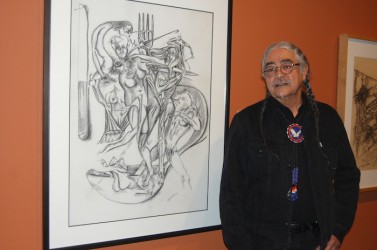Article Origin
Volume
Issue
Year
March 9, 2016.
Curator Michelle Lavalee is fond of saying 7: Professional Native Indian Artists Inc. exhibition is “retroactive” not retrospective.
The exhibition, which showcases the work of what became known as the “Indian Group of Seven,” opened on Saturday at the Art Gallery of Alberta, in Edmonton. It is the final stop on a six-venue tour, which began in 2013.
“People like to refer to is as a retrospective exhibition, possibly because of the time period that this art work focuses on but I don’t see it as a retrospective exhibition or a simple look back. I view it as a retroactive exhibition because it is something that could have happened and should have happened 40 years ago,” said Lavalee.
Photo: Joseph Sanchez by his work entitled, Businessmen’s Lunch, which is a depiction of the common practise (at that time) of nude dancing at lunch time in Winnipeg. “It is about the fact that women have been disrespected for so long in this society,” said Sanchez. “I mostly paint from a feminist point of view. We need to protect women.”
Photo: Shari Narine
Although the show originated at the MacKenzie Art Gallery, in Regina, where Lavalee curates, she is quick to point out that the concept is not her idea. Both Indigenous and non-Indigenous supporters have been calling for such a showcase of the work from the 1970s, the decade when the artists were active as a group.
“I found my place in a position to be able to facilitate this. I feel privileged,” said Lavalee.
The exhibition, with over 80 paintings and drawings pulled from public and private collections, represents the first time so many pieces by the artists have been together in a single space.
Joseph Sanchez is the youngest member of the Indian Group of Seven. He was in Edmonton for the show’s opening. His pieces on display, he points out, are the works that he owns.
“We could not find my work in Canada after 45 years,” he said. There were no pieces in museums and his agent could not be found.
This lack of archived work, says Sanchez, is only one indication of the lack of respect shown to art created by Indigenous peoples. For many, many years, Indigenous artists were seen as craftspeople and not artists, unlike people like Mark Rothko and Jackson Pollock, who were influenced by Indigenous culture.
Sanchez says respect has finally been given to the Indian Group of Seven, with three of the members getting shows in the National Gallery of Canada. In 2006, Norval Morrisseau became the national gallery’s first major solo exhibition of a First Nations artist. He passed away a year after his showing. In 2010, Daphne Odjig, who is credited as the founder of the group, became the gallery’s first solo exhibition of a First Nations woman artist. This fall, Alex Janvier’s work will make its way to the national gallery. Janvier has his own gallery in Cold Lake First Nation.
Other members of the Indian Group of Seven are Jackson Beardy (1944-1984), Eddy Cobiness (1933-1996), and Carl Ray (1942-1978).
“It took 45 years, but here we are,” said Sanchez, who credits the other artists with guiding him and being supportive.
“I think this is giving us a glimpse of a vision that flourished despite the barriers they faced. This is what they fought for over 40 years ago. I think they (the artists who have passed away) would be very happy,” said Lavalee.
The Art Gallery of Alberta exhibition is the last chance to see these works presented together in Canada. The show made stops at the Kelowna Art Gallery, McMichael Canadian Art Collection (Kleinburg, Ont.) and the Art Gallery of Windsor. The exhibition is open until July 3 in the Edmonton location.
- 2040 views

